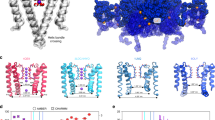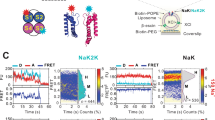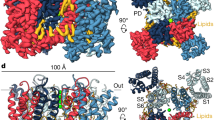Abstract
The potassium channel selectivity filter both discriminates between K+ and sodium ions and contributes to gating of ion flow. Static structures of conducting (open) and nonconducting (inactivated) conformations of this filter are known; however, the sequence of protein rearrangements that connect these two states is not. We show that closure of the selectivity filter gate in the human Kv11.1 K+ channel (also known as hERG, for ether-a-go-go–related gene), a key regulator of the rhythm of the heartbeat, is initiated by K+ exit, followed in sequence by conformational rearrangements of the pore domain outer helix, extracellular turret region, voltage sensor domain, intracellular domains and pore domain inner helix. In contrast to the simple wave-like sequence of events proposed for opening of ligand-gated ion channels, a complex spatial and temporal sequence of widespread domain motions connect the open and inactivated states of the Kv11.1 K+ channel.
This is a preview of subscription content, access via your institution
Access options
Subscribe to this journal
Receive 12 print issues and online access
$189.00 per year
only $15.75 per issue
Buy this article
- Purchase on Springer Link
- Instant access to full article PDF
Prices may be subject to local taxes which are calculated during checkout







Similar content being viewed by others
References
Doyle, D.A. et al. The structure of the potassium channel: molecular basis of K+ conduction and selectivity. Science 280, 69–77 (1998).
Yellen, G. The voltage-gated potassium channels and their relatives. Nature 419, 35–42 (2002).
Bernèche, S. & Roux, B. A gate in the selectivity filter of potassium channels. Structure 13, 591–600 (2005).
Henzler-Wildman, K. & Kern, D. Dynamic personalities of proteins. Nature 450, 964–972 (2007).
Clarke, O.B. et al. Domain reorientation and rotation of an intracellular assembly regulate conduction in Kir potassium channels. Cell 141, 1018–1029 (2010).
Cuello, L.G., Jogini, V., Cortes, D.M. & Perozo, E. Structural mechanism of C-type inactivation in K+ channels. Nature 466, 203–208 (2010).
Long, S.B., Tao, X., Campbell, E.B. & MacKinnon, R. Atomic structure of a voltage-dependent K+ channel in a lipid membrane-like environment. Nature 450, 376–382 (2007).
Fersht, A.R. From the first protein structures to our current knowledge of protein folding: delights and scepticisms. Nat. Rev. Mol. Cell Biol. 9, 650–654 (2008).
Fersht, A.R., Leatherbarrow, R.J. & Wells, T.N.C. Quantitative analysis of structure-activity relationships in engineered proteins by linear free-energy relationships. Nature 322, 284–286 (1986).
Fersht, A.R., Matouschek, A. & Serrano, L. The folding of an enzyme. I. Theory of protein engineering analysis of stability and pathway of protein folding. J. Mol. Biol. 224, 771–782 (1992).
Fersht, A.R. Relationship of Leffler (Bronsted) alpha values and protein folding Phi values to position of transition-state structures on reaction coordinates. Proc. Natl. Acad. Sci. USA 101, 14338–14342 (2004).
Grosman, C., Zhou, M. & Auerbach, A. Mapping the conformational wave of acetylcholine receptor channel gating. Nature 403, 773–776 (2000).
Purohit, P., Mitra, A. & Auerbach, A. A stepwise mechanism for acetylcholine receptor channel gating. Nature 446, 930–933 (2007).
Zhou, Y., Pearson, J.E. & Auerbach, A. Phi-value analysis of a linear, sequential reaction mechanism: theory and application to ion channel gating. Biophys. J. 89, 3680–3685 (2005).
Sanguinetti, M.C. & Tristani-Firouzi, M. hERG potassium channels and cardiac arrhythmia. Nature 440, 463–469 (2006).
Perrin, M.J., Kuchel, P.W., Campbell, T.J. & Vandenberg, J.I. Drug binding to the inactivated state is necessary but not sufficient for high-affinity binding to human ether-a-go-go-related gene channels. Mol. Pharmacol. 74, 1443–1452 (2008).
Smith, P.L., Baukrowitz, T. & Yellen, G. The inward rectification mechanism of the HERG cardiac potassium channel. Nature 379, 833–836 (1996).
Vandenberg, J.I., Torres, A.M., Campbell, T.J. & Kuchel, P.W. The HERG K+ channel: progress in understanding the molecular basis of its unusual gating kinetics. Eur. Biophys. J. 33, 89–97 (2004).
Ju, P. et al. The pore domain outer helix contributes to both activation and inactivation of the HERG K+ channel. J. Biol. Chem. 284, 1000–1008 (2009).
Liu, J., Zhang, M., Jiang, M. & Tseng, G.N. Structural and functional role of the extracellular s5-p linker in the HERG potassium channel. J. Gen. Physiol. 120, 723–737 (2002).
Piper, D.R., Hinz, W.A., Tallurri, C.K., Sanguinetti, M.C. & Tristani-Firouzi, M. Regional specificity of human ether-a-go-go-related gene channel activation and inactivation gating. J. Biol. Chem. 280, 7206–7217 (2005).
Torres, A.M. et al. Structure of the HERG K+ channel S5P extracellular linker: role of an amphipathic alpha-helix in C-type inactivation. J. Biol. Chem. 278, 42136–42148 (2003).
Zou, A., Xu, Q.P. & Sanguinetti, M.C. A mutation in the pore region of HERG K+ channels expressed in Xenopus oocytes reduces rectification by shifting the voltage dependence of inactivation. J. Physiol. (Lond.) 509, 129–137 (1998).
Sanguinetti, M.C., Jiang, C., Curran, M.E. & Keating, M.T. A mechanistic link between an inherited and an acquired cardiac arrhythmia: HERG encodes the IKr potassium channel. Cell 81, 299–307 (1995).
Wang, S., Liu, S., Morales, M.J., Strauss, H.C. & Rasmusson, R.L. A quantitative analysis of the activation and inactivation kinetics of HERG expressed in Xenopus oocytes. J. Physiol. (Lond.) 502, 45–60 (1997).
Kiehn, J., Lacerda, A.E. & Brown, A.M. Pathways of HERG inactivation. Am. J. Physiol. 277, H199–H210 (1999).
Gang, H. & Zhang, S. Na+ permeation and block of hERG potassium channels. J. Gen. Physiol. 128, 55–71 (2006).
Zou, A., Curran, M.E., Keating, M.T. & Sanguinetti, M.C. Single HERG delayed rectifier K+ channels expressed in Xenopus oocytes. Am. J. Physiol. 272, H1309–H1314 (1997).
Jackson, S.E. & Fersht, A.R. Folding of chymotrypsin inhibitor 2. 1. Evidence for a two-state transition. Biochemistry 30, 10428–10435 (1991).
Clarke, C.E. et al. Effect of S5P alpha-helix charge mutants on inactivation of hERG K+ channels. J. Physiol. (Lond.) 573, 291–304 (2006).
Cordero-Morales, J.F. et al. Molecular driving forces determining potassium channel slow inactivation. Nat. Struct. Mol. Biol. 14, 1062–1069 (2007).
Liu, Y., Jurman, M.E. & Yellen, G. Dynamic rearrangement of the outer mouth of a K+ channel during gating. Neuron 16, 859–867 (1996).
Cymes, G.D., Grosman, C. & Auerbach, A. Structure of the transition state of gating in the acetylcholine receptor channel pore: a phi-value analysis. Biochemistry 41, 5548–5555 (2002).
Yellen, G., Sodickson, D., Chen, T.Y. & Jurman, M.E. An engineered cysteine in the external mouth of a K+ channel allows inactivation to be modulated by metal binding. Biophys. J. 66, 1068–1075 (1994).
Fersht, A.R., Leatherbarrow, R.J. & Wells, T.N. Structure-activity relationships in engineered proteins: analysis of use of binding energy by linear free energy relationships. Biochemistry 26, 6030–6038 (1987).
Ozkan, S.B., Bahar, I. & Dill, K.A. Transition states and the meaning of Phi-values in protein folding kinetics. Nat. Struct. Biol. 8, 765–769 (2001).
Cuello, L.G. et al. Structural basis for the coupling between activation and inactivation gates in K+ channels. Nature 466, 272–275 (2010).
Ferrer, T., Rupp, J., Piper, D.R. & Tristani-Firouzi, M. The S4-S5 linker directly couples voltage sensor movement to the activation gate in the human ether-a-go-go-related gene (hERG) K+ channel. J. Biol. Chem. 281, 12858–12864 (2006).
Ader, C. et al. Coupling of activation and inactivation gate in a K+-channel: potassium and ligand sensitivity. EMBO J. 28, 2825–2834 (2009).
Baukrowitz, T. & Yellen, G. Modulation of K+ current by frequency and external [K+]: a tale of two inactivation mechanisms. Neuron 15, 951–960 (1995).
Cordero-Morales, J.F. et al. Molecular determinants of gating at the potassium-channel selectivity filter. Nat. Struct. Mol. Biol. 13, 311–318 (2006).
López-Barneo, J., Hoshi, T., Heinemann, S.H. & Aldrich, R.W. Effects of external cations and mutations in the pore region on C-type inactivation of Shaker potassium channels. Receptors Channels 1, 61–71 (1993).
Baukrowitz, T. & Yellen, G. Use-dependent blockers and exit rate of the last ion from the multi-ion pore of a K+ channel. Science 271, 653–656 (1996).
Ogielska, E.M. & Aldrich, R.W. Functional consequences of a decreased potassium affinity in a potassium channel pore. Ion interactions and C-type inactivation. J. Gen. Physiol. 113, 347–358 (1999).
Jiang, Y. et al. The open pore conformation of potassium channels. Nature 417, 523–526 (2002).
Auerbach, A. How to turn the reaction coordinate into time. J. Gen. Physiol. 130, 543–546 (2007).
Piper, D.R., Varghese, A., Sanguinetti, M.C. & Tristani-Firouzi, M. Gating currents associated with intramembrane charge displacement in HERG potassium channels. Proc. Natl. Acad. Sci. USA 100, 10534–10539 (2003).
Subbiah, R.N. et al. Molecular basis of slow activation of the human ether-a-go-go related gene potassium channel. J. Physiol. (Lond.) 558, 417–431 (2004).
Bafna, P.A., Jha, A. & Auerbach, A. Aromatic residues {epsilon}Trp-55 and {delta}Trp-57 and the activation of acetylcholine receptor channels. J. Biol. Chem. 284, 8582–8588 (2009).
Chen, J., Seebohm, G. & Sanguinetti, M.C. Position of aromatic residues in the S6 domain, not inactivation, dictates cisapride sensitivity of HERG and eag potassium channels. Proc. Natl. Acad. Sci. USA 99, 12461–12466 (2002).
Kurata, H.T. & Fedida, D. A structural interpretation of voltage-gated potassium channel inactivation. Prog. Biophys. Mol. Biol. 92, 185–208 (2006).
Larsson, H.P. & Elinder, F. A conserved glutamate is important for slow inactivation in K+ channels. Neuron 27, 573–583 (2000).
Panyi, G. & Deutsch, C. Cross talk between activation and slow inactivation gates of Shaker potassium channels. J. Gen. Physiol. 128, 547–559 (2006).
Zhao, J.T. et al. Not all hERG pore domain mutations have a severe phenotype: G584S has an inactivation gating defect with mild phenotype compared to G572S, which has a dominant negative trafficking defect and a severe phenotype. J. Cardiovasc. Electrophysiol. 20, 923–930 (2009).
Vandenberg, J.I. et al. Temperature dependence of human ether-a-go-go-related gene K+ currents. Am. J. Physiol. Cell Physiol. 291, C165–C175 (2006).
Acknowledgements
We thank E. Perozo for providing preprints of papers in press; R.M Graham, A. Husain, L. Lee, B. Martinac, E. Perozo and M. Sunde for participating in critical discussions and for reading the manuscript; and K. Wyse and T. Marciniec for making technical contributions. This research was supported by project grants from the National Health and Medical Research Council of Australia (NHMRC, grants 459402 and 635520) and fellowships to J.V. (NHMRC grant 459401) and to A.H. (National Heart Foundation of Australia grant PF 08S 3956).
Author information
Authors and Affiliations
Corresponding author
Ethics declarations
Competing interests
The authors declare no competing financial interests.
Supplementary information
Supplementary Text and Figures
Supplementary Figures 1–4 and Supplementary Table 1 (PDF 1037 kb)
Rights and permissions
About this article
Cite this article
Wang, D., Hill, A., Mann, S. et al. Mapping the sequence of conformational changes underlying selectivity filter gating in the Kv11.1 potassium channel. Nat Struct Mol Biol 18, 35–41 (2011). https://doi.org/10.1038/nsmb.1966
Received:
Accepted:
Published:
Issue Date:
DOI: https://doi.org/10.1038/nsmb.1966
This article is cited by
-
Noncanonical electromechanical coupling paths in cardiac hERG potassium channel
Nature Communications (2023)
-
Structure of potassium channels
Cellular and Molecular Life Sciences (2015)
-
The isoforms generated by alternative translation initiation adopt similar conformation in the selectivity filter in TREK-2
Journal of Physiology and Biochemistry (2015)
-
The voltage-dependent gate in MthK potassium channels is located at the selectivity filter
Nature Structural & Molecular Biology (2013)



